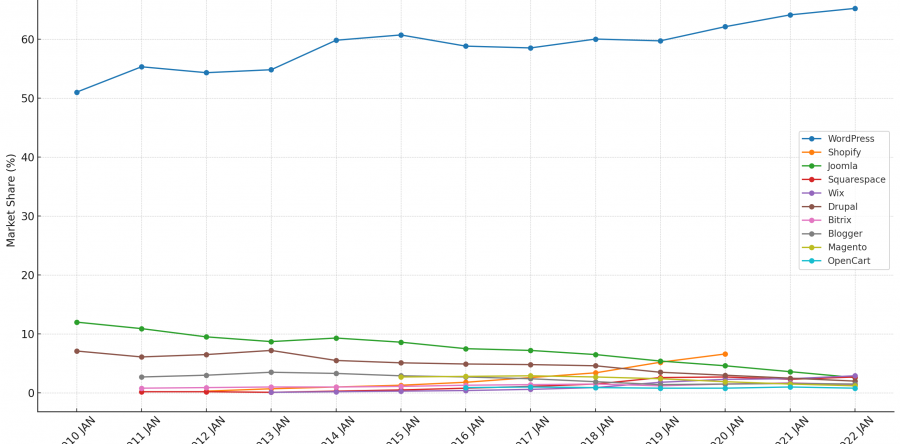In the digital age we live in today, the tools we use to manage and share online content have become crucial. Content management systems (CMS) are the backbone of many websites we visit every day, from personal blogs to elaborate e-commerce sites.
The Evolution of the CMS
Ten years ago, the world of web development was quite different. According to data, 76% of websites were hand-coded at the time. Fast-forward to 2023, and that figure dropped dramatically to 36%. CMS systems such as WordPress, Shopify, Magento and Wix have transformed the way we build and manage websites.
The most popular CMS systems
When diving into the market share data for CMS systems, one name immediately jumps out: WordPress. Between 2010 and 2022, WordPress' market share grew from 51% to an impressive 65.2%.
But WordPress is not the only player in the field. Shopify, which focuses specifically on e-commerce, began to tighten its grip on the market around 2013 and saw steady growth in the following years. In addition, Magento, also focused on e-commerce, has a reputation for flexibility and customization. This allows developers to customize complex tools and functionalities, such as product configurators.
Older CMS platforms such as Joomla and Drupal, however, have lost some wind out of their sails, with their market shares declining every year.
Is there anything to choose from?
With such a diverse range of CMS options, the answer is a resounding yes. Each CMS offers its own set of tools, functionalities and benefits.
WordPress and its e-commerce extension, WooCommerce, are known for their customizability and flexibility, with an almost endless library of themes and plug-ins that users can use. This flexibility allows for specific custom extensions, such as product configurators or advanced search functions.
Magento, another prominent e-commerce platform, is also known for its high level of customizability and flexibility. Its modular architecture allows developers to build complex modules and extensions on demand. This makes Magento ideally suited for companies that need specific functionalities that are not readily available in off-the-shelf solutions. As with WordPress and WooCommerce, Magento allows the development of customized solutions such as product configurators and other specialized e-commerce tools.
Shopify, on the other hand, while perhaps less flexible than WordPress partly because it's not open-source*, offers a powerful set of tools specifically designed for online stores.
For those looking for a simpler solution without the hassle of dealing with hosting or maintenance, website builders like Wix and Squarespace (which are also not open-source*) are popular choices.
Conclusion
2023 certainly offers a wealth of choices when it comes to CMS systems. And while WordPress is clearly preferred by many users and developers, there are numerous other options available that may be better suited to specific needs. It is critical for individuals and businesses to choose the CMS that best suits their specific needs and skills. The digital landscape is constantly evolving, and choosing the right platform now can help ensure long-term success.
Source: Market shares of top 10 CMSs between 2010-2022 (W3Techs)
| CMS | 2010 Jan | 2011 Jan | 2012 Jan | 2013 Jan | 2014 Jan | 2015 Jan | 2016 Jan | 2017 Jan | 2018 Jan | 2019 Jan | 2020 Jan | 2021 Jan | 2022 Jan |
|---|---|---|---|---|---|---|---|---|---|---|---|---|---|
| WordPress(OS) | 51.0% | 55.3% | 54.3% | 54.8% | 59.8% | 60.7% | 58.8% | 58.5% | 60.0% | 59.7% | 62.1% | 64.1% | 65.2% |
| Shopify | 0.3% | 0.7% | 1.0% | 1.3% | 1.8% | 2.6% | 3.4% | 5.2% | 6.6% | ||||
| Joomla(OS) | 12.0% | 10.9% | 9.5% | 8.7% | 9.3% | 8.6% | 7.5% | 7.2% | 6.5% | 5.4% | 4.6% | 3.6% | 2.6% |
| Squarespace | 0.2% | 0.2% | 0.1% | 0.3% | 0.5% | 0.8% | 1.1% | 1.5% | 2.6% | 2.7% | 2.3% | 2.7% | |
| Wix | <0.1% | 0.2% | 0.3% | 0.4% | 0.6% | 0.9% | 1.8% | 2.3% | 2.4% | 2.9% | |||
| Drupal(OS) | 7.1% | 6.1% | 6.5% | 7.2% | 5.5% | 5.1% | 4.9% | 4.8% | 4.6% | 3.5% | 3.0% | 2.5% | 2.0% |
| Bitrix | 0.8% | 0.9% | 1.0% | 1.0% | 1.1% | 1.3% | 1.4% | 1.5% | 1.2% | 1.5% | 1.7% | 1.4% | |
| Blogger | 2.7% | 3.0% | 3.5% | 3.3% | 2.9% | 2.7% | 2.4% | 1.9% | 1.4% | 1.5% | 1.6% | 1.5% | |
| Magento(OS) | 2.7% | 2.8% | 2.9% | 2.7% | 2.4% | 1.9% | 1.5% | 1.2% | 1.1% | ||||
| OpenCart(OS) | 0.9% | 1.0% | 0.9% | 0.8% | 0.8% | 0.8% | 1.0% | 0.8% |
Legenda: OS - Open-source
* Definition and Advantages of Open-source
Open-source: Open-source software is software whose source code is freely accessible to the public. This offers entrepreneurs complete freedom and independence in various ways:
- Freedom to Customize: Entrepreneurs can modify the software to meet their specific needs.
- Self-hosting: This allows them to have full control over their web environment and not be dependent on third-party hosting.
- Vendor Independence: No risk of sudden price changes or service terminations by a specific service provider.
- Active Community: Many open-source software is supported by an active community that regularly provides updates, patches, and new features.
- Transparency: Due to the open nature of the software, users have insight into the source code and can assess and address any security or performance issues on their own.


